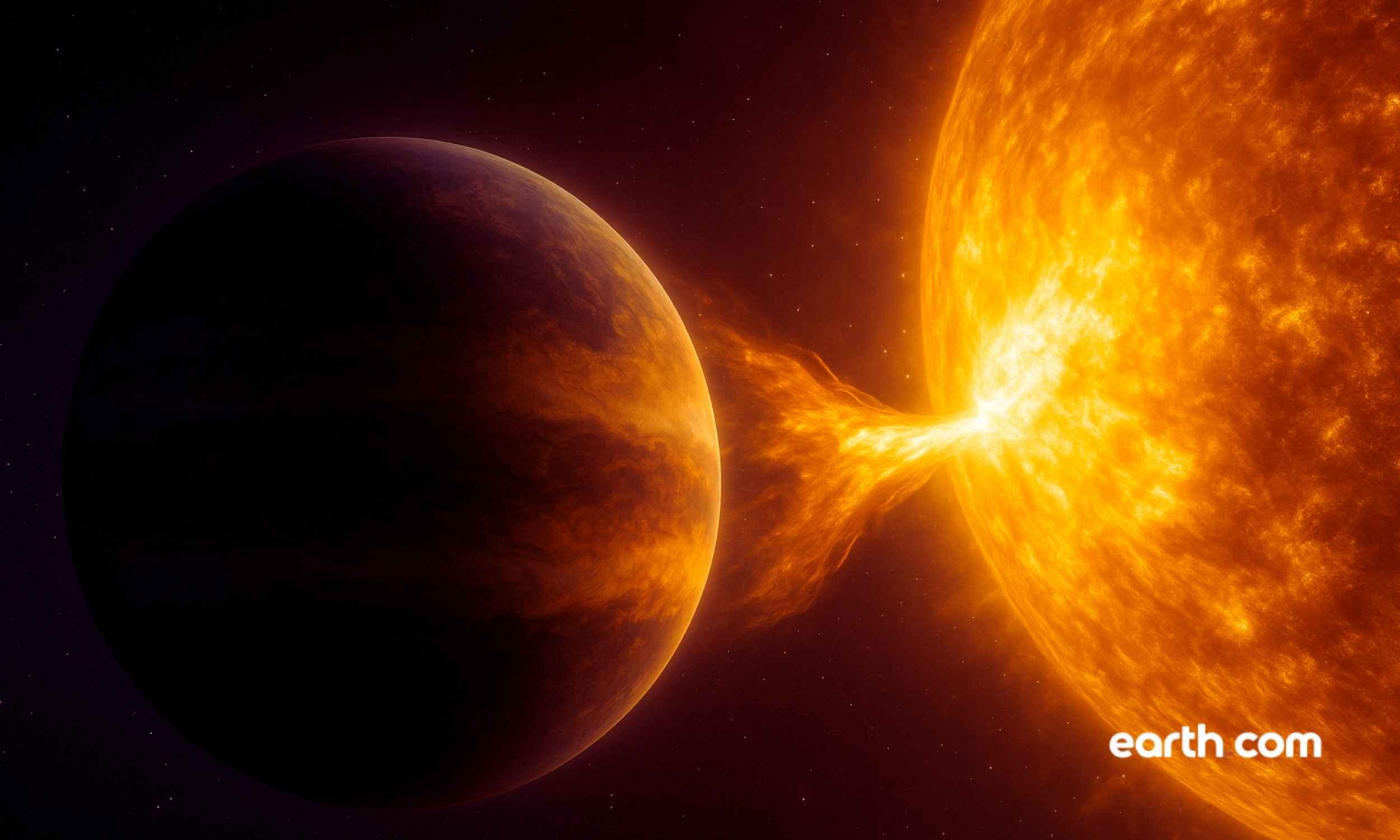Astronomers discovered a strange exoplanet, HIP 67522 b, that orbiting a star roughly 417 light‑years away. Because the planet’s orbit is just seven days long, the gravitational forces from this orbital path tug at the star until plasma erupts from the surface.
Researchers now say those eruptions pump extra heat into the planet’s bloated atmosphere, setting it on a course toward a dramatic weight‑loss plan.
Dr. Ekaterina Ilin of ASTRON, Dr. Katja Poppenhäger of the Leibniz‑Institut für Astrophysik Potsdam, and Dr. Harish Vedantham of ASTRON unraveled this cosmic feedback loop by scouring five years of space‑telescope data.
HIP 67522 b causes star eruptions
Most suns spew occasional flare explosions when tangled magnetic fields snap, yet HIP 67522 lights up more often near the moment its innermost exoplanet crosses the stellar disk.
That timing pins the blame on the planet’s motion rather than on random stellar moods. The research team tracked this smoking gun with NASA’s Transiting Exoplanet Survey Satellite (TESS).
HIP 67522 b belongs to the family of hot Jupiter gas giants that hug their suns far tighter than Mercury does ours, soaking up fierce radiation.
Because the planet sits inside the star’s sprawling magnetic field, its own motion drags field lines like stretched rubber bands.
When these magnetic field lines become twisted and then released, energy is blasted back toward both bodies.
“ We’ve found the first clear evidence of flaring star‑planet interaction, where a planet triggers energetic eruptions on its host star, ” said Dr. Ilin.
She noted that the flare‑boosting partnership has persisted for at least three years, long enough to measure its toll.
A teenager among planets
Astronomers estimate that the HIP 67522 system is only 17 million years old, a mere adolescent by cosmic standards.
Youth matters because young stars spin fast, drive stronger magnetism, and shower nearby worlds with charged particles.
HIP 67522 b inflates to roughly Jupiter’s width even though its mass is lower, suggesting that starlight and particle storms have puffed up its skies.
James Webb Space Telescope (JWST) observations already hint at an extended shroud of hydrogen escaping the planet, which matches models of photoevaporation.
“ The planet is essentially subjecting itself to an intense bombardment of radiation and particles from these induced flares,” stated Dr. Vedantham.
He suspects that self‑inflicted space weather speeds up atmospheric escape, a process that can strip thousands of tons of gas from a planet each second.
HIP 67522 b is rapidly shrinking
Computer simulations of star‑planet electromagnetic coupling predict that the extra flare energy pours into the planet’s upper layers, raising temperatures by hundreds of degrees Fahrenheit.
Heat causes the air to swell, increasing the cross‑section that stellar ultraviolet rays can hit, and leading to a vicious cycle that accelerates mass loss.
If the current pace holds, HIP 67522 b could shed enough hydrogen and helium to shrink into a mini‑Neptune within 100 million years.
It may even become a bare, rocky core after that. Such transformations explain why many mature planetary systems harbor small sub‑Neptunes while very close giant planets are rarer.
Similar run‑away erosion may have sculpted planets like CoRoT‑7 b, where today only a scorched super‑Earth remains. Watching HIP 67522 b in real time offers a front‑row seat to the earlier stages of that evolution.
Telltale signals from space telescopes
TESS supplied continuous light curves that revealed minute brightness bumps whenever a flare lit up the surface. European Space Agency’s CHEOPS spacecraft refined the planet’s transit clock, confirming the synergy between orbit and explosion.
Out of fifteen reliable flares tagged by the team, eleven clustered near the transit phase, a pattern with less than a 1 in 10,000 chance of happening by luck.
An accompanying radio survey with the Australian Telescope Compact Array saw the star crackle but missed any planet‑powered radio bursts, likely because such flashes were too faint to detect.
Magnetohydrodynamic models predict that radio signatures scale with planetary magnetic strength, and a bloated gas giant may not host the punchy field required.
Even so, the optical confirmation alone cements HIP 67522 as the strongest laboratory yet for star‑planet interaction.
Many more systems like HIP 67522
Thousands of planets race around their host stars in orbits shorter than ten days, and many of those stars are quieter and older than HIP 67522.
If a youthful planet can already damage itself through magnetic mischief, older cousins might once have looked very different.
Flaring star‑planet pairs also complicate the hunt for life. Energetic particles break apart molecules, including water and methane, which are key ingredients that telescopes search for when sizing up habitability.
Astronomers now plan to aim the Hubble Space Telescope’s ultraviolet spectrograph at HIP 67522 b during future transits, hoping to catch escaping gas in the act.
Ground arrays such as the upcoming Square Kilometre Array could chase elusive radio sparks, testing the limits of planetary dynamos.
More reliable data will come as TESS continues its mission and CHEOPS transitions to Europe’s PLATO later this decade.
By comparing planets of various ages and orbits around their stars, scientists expect to map how magnetic violence writes, and erases, planetary atmospheres.
This drama that is unfolding in the Centaurus constellation shows that the relationship between a planet and its star is anything but one-sided.
The study is published in Nature.
—–
Like what you read? Subscribe to our newsletter for engaging articles, exclusive content, and the latest updates.
Check us out on EarthSnap, a free app brought to you by Eric Ralls and Earth.com.
—–
